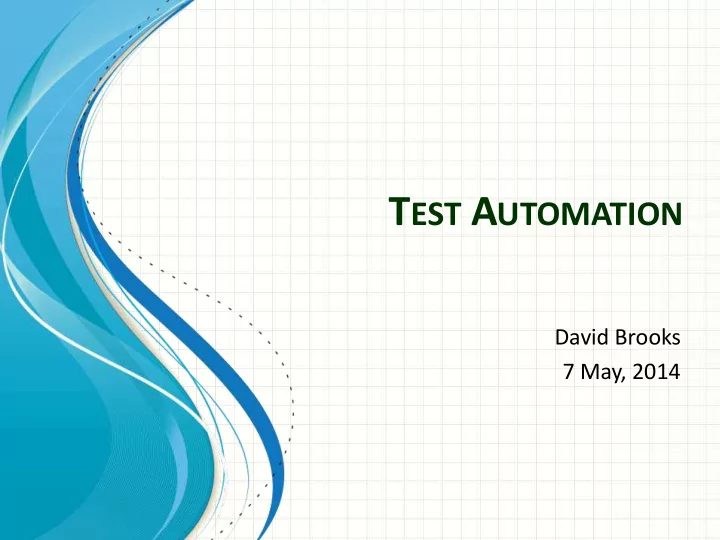

T EST A UTOMATION David Brooks 7 May, 2014
Who Am I? • Working in Test Automation since 2008 at WorkCoverSA • 18 years in Software Testing / Quality Assurance • Previously have worked at Adelaide Bank, Australian Taxation Office, Aspect Computing and others • Connect with me on LinkedIn
What is Test Automation? • Test Automation is the use of a third party (or internally developed) product to interact with the software under test to replicate the interactions of “real users” • Good automation provides stable, reliable and repeatable testing with little human interaction • However, it is NOT the answer to everything – some things are not suitable for test automation
How can Test Automation be used? • Execution of test scripts / test cases • Data creation • Checking the flow of data from one system to another (System Integration Testing) • Functional and Performance Testing • Output / storage of test data • Results Analysis and Comparisons
Reasons to use Test Automation • Repeatability, Reliability, Consistency, Accuracy • Test Scripts can be executed by anybody with access to the Automated Testing Tool • Can be scheduled to run overnight / weekends • Extremely cost-effective over the medium to long term – Regression Testing time can be significantly reduced – Massive amounts of data can be created as required
Which Automation Tool to use? • Open Source Tools – Selenium – TOSCA – SoapUI – Many more • Licensed Tools – HP Quick Test Pro (QTP) / HP Unified Functional Testing (UFT) – IBM Rational Suite – Compuware Tools (QARun)
Where to begin? • What testing, if automated, would benefit you the most? • Develop an Automation Strategy document, outlining cost v benefit analysis • Consider which Automation Tools would best fit your needs
Selecting an Automated Test Tool • Depends on many factors, including: – Technology – Cost – Available Support – Automation skills available in the market
Attributes of successful Automation • Has management support • Has an initial Proof of Concept • Is documented • Must be easy to use • Has a development AND test phase (if possible) • Uses “Quick Wins” to show early benefits to the organisation • Automated Test Scripts and Test Data are created AND owned by manual testers
Attributes of successful Automation..more • Has re-usable data • Uses a central object repository to store information about screens/controls etc • Uses a central code library to reduce code duplication • Uses common naming conventions • Is promoted by the Automation Testing Team when possible
What NOT to do….. • Don’t assume that Test Automation is a “silver bullet” • Know and understand it’s limitations • Don’t jump in as soon as you get the tool – a Proof of Concept can save you a lot of pain later on • Don’t shut yourself off – there is a wealth of information out there • Don’t assume your Automation Framework is perfect – there is always room for improvement.
Questions?
Recommend
More recommend